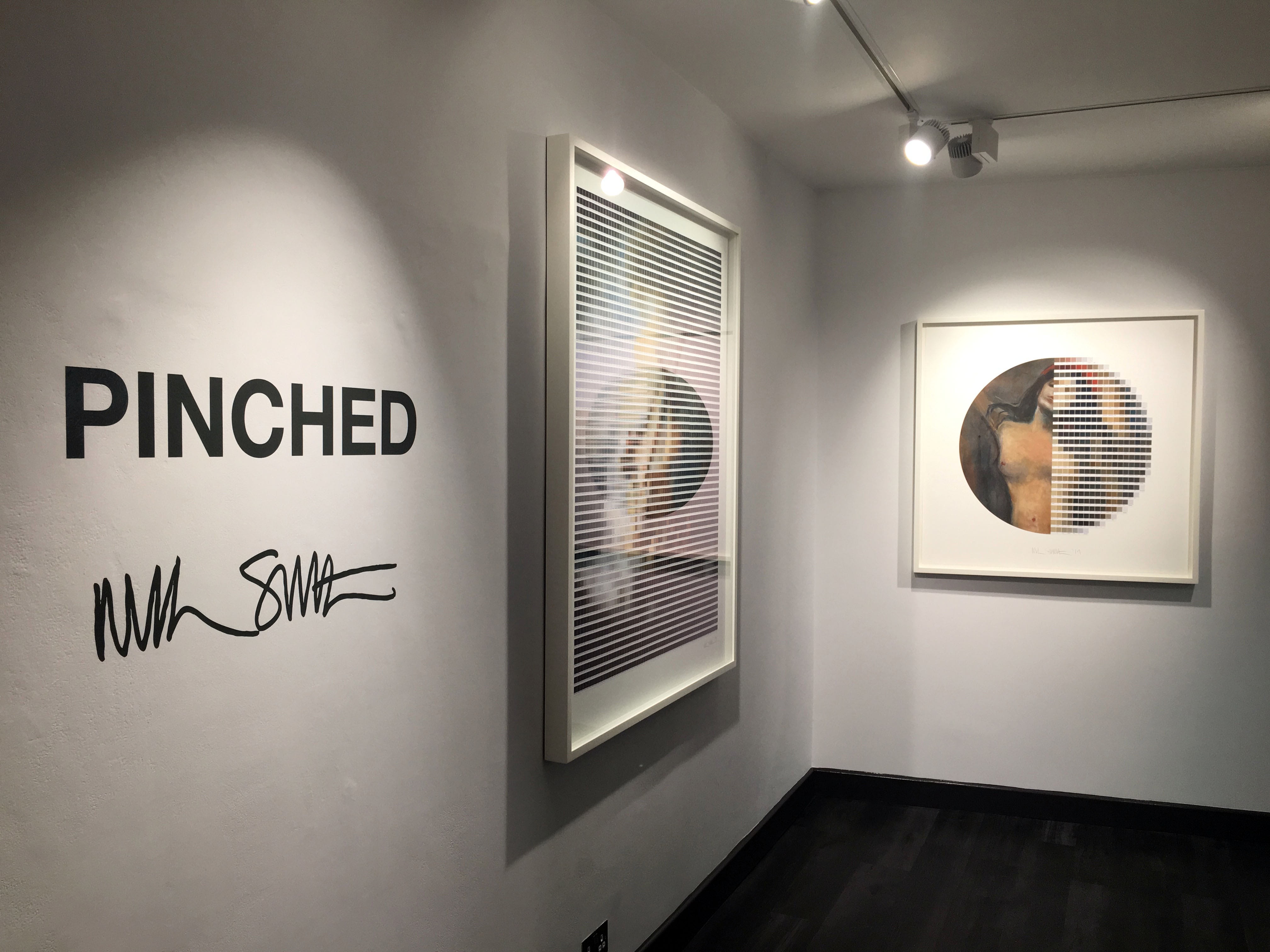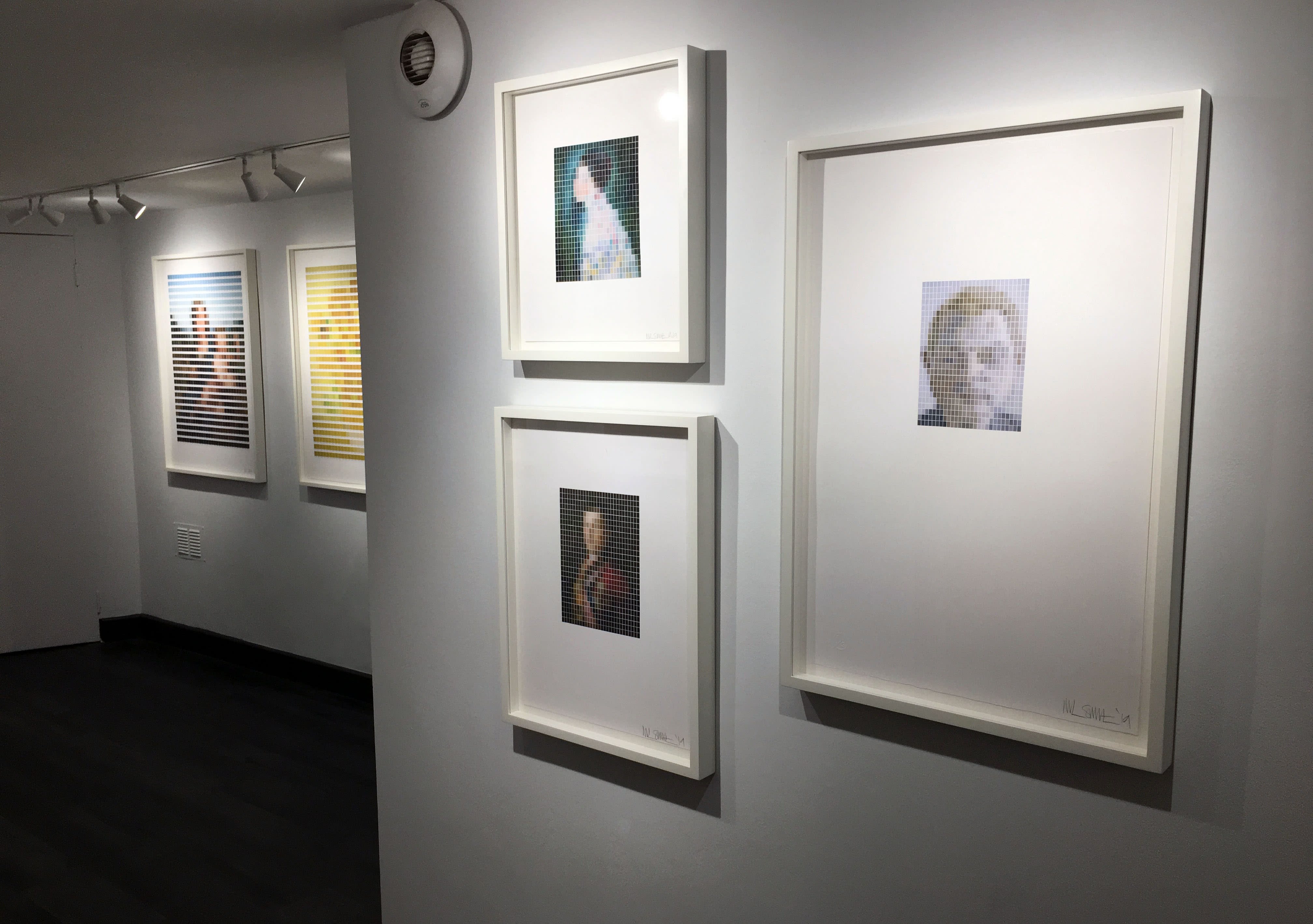We wish to congratulate Nick on another brilliant body of new work. Smith is internationally known for deconstructing famous artworks using colour-chips; pixilating the images and recreating them in collage. The show Pinched is a collection of 20 new pieces, exploring questions around art theft and the financial and cultural impact which surrounds it. Each piece represents a work or art or object which has once been stolen, from the Mona Lisa to CCTV images of thefts. The show captures and reflects on many real stories surrounding the art economy and subsequent throughout history.
“Each piece lost represents a partial loss of our heritage and art history. My fascination is not with the images themselves, but the stories behind the thefts. What is the motivation? And how does the theft influence the artwork’s place in our current cultural landscape?”

Nick Smith’s work has many layers of interaction and interrogation. By looking at the pieces through a camera phone or a digital screen, the works change, allowing the viewer to see the bigger pictures being represented. When viewed up close, the viewer can read the message written under each colour-chip, leading to a linear narrative within the piece.
We managed to have a quick chat with Nick about his work, inspiration and processes:
Q: What made you transition from studying Product Design to commercial interior design to now being a full-time artist? How did this impact your work?
The desire for an autonomous, dynamic lifestyle and to be intentional with my career. When you work for someone else you don't have full creative freedom. I got to a point where I needed further freedom. It became apparent that the next step on from being a designer is being an artist.
Q: What are your next steps and goals in your career?
I’d like to explore more immersive work, further encouraging the dialogue between artist, artwork and audience through the environment the art is presented in.

Q: What got you interested in art theft and the idea of Pinched?
My previous show titled ‘Priceless’ explored the monetary value we attach to famous artworks. It felt logical that the next step in this commentary would be to explore the temptations created by that immense value and to acknowledge how that can sometimes lead to its loss. Bizarrely, Art theft is glamourized over other types of theft. Partly because most of the valuable stuff goes missing from establishment museums and thus is perceived as a victimless crime; but mostly because it makes great conversation, as it nearly always comes with a film worthy plot. I became fascinated by how the theft of an artwork could increase its notoriety and its perceived value.
Q: What piece are you most proud of in the show?
When working on a new collection I spend the majority of my time in my studio with a lovely large desk on which to make each piece - the perfect conditions to create, but not the most social of spaces. As this show has coincided with the final months of my wife’s pregnancy as we anticipate the arrival of our first child, I wanted to spend more time with her out of my studio. As her needs developed, so did my work. I created smaller pieces, able to be made in alternative locations, ensuring I wasn't missing out on this incredible transformative experience.
You ask which work I am most proud of in the show... probably the one that afforded me more time with my wife... the smallest in the show, which evolved in to the microchip series. The Rembrandt self-portrait.
Q: How has your practice changed and evolved from Priceless?
We recently moved home and I now have a purpose-built studio in which to work, as opposed to a room with a desk in it. Physically, I have more flexibility allowing me to work at different heights and positions, more space to display and compare works in progress and lighter. It’s taken a long time to get to this stage and it’s made a significant difference in the satisfaction I get from creating new work. My surroundings feel more resolved and thus I feel more in tune in my approach to new work.

Q: When, and how did you come up to introducing text to your pieces, how do you research and produce these linear narratives?
When I ran out of Pantone swatch books. It was either buy more or print your own. I realized when invited to exhibit with Lawrence Alkin gallery in early 2015. I quickly perceived that under the time frame and budget it wouldn't be possible if I were to use the branded chips. Not sure when it happened exactly, but, around December 2014, I saw that there was an opportunity to make my own narrative in artworks by printing my own colour chips.... also, this meant that I wasn't constricted by Pantone's limited selection of colours. I could choose whatever colour I needed and also apply any narrative below. It was an organic process that came from a genuine need to resolve a creative constraint. That was when and how it happened.
Q: From research to creating your colour chips, how long did it take you to create this whole show?
Difficult equation. A life time or four months. The show was physically made in four months, but it was created by 38 years of soaking up information. Sorry I can't be more specific.
Q: Your piece “Monet – Beach at Pourville” has a different approach to its subject matter and story in comparison to the rest, how did you find this experience? are you planning on experimenting more without the use of colour chips more?
As expressed earlier, I have an innate need for personal and creative freedom. During the development stages of each collection of works I get to a point where I must work outside the box - quite literally. You’ll have seen it manifest in my previous collections with the exploration of found objects and alternate materials - The Magazine Series, my Tape Collection, the Yves Klein’s, etc.
Monet's Beach at Pourville provided an opportunity to harness that freedom.
When researching the stories behind the major art heists of our time, the story behind this piece was most inspiring. I’m interested in how we display and view art - particularly in galleries and museums, and so the idea of the thief visiting the gallery, making rough sketches sat in front of the piece, painting a naive forgery, the brazen act of slashing the original and replacing it with his own to then have it hang for several hours…it played into my developing romanticism surrounding art making, value, consumption and ownership.
Also…I have many friends who paint, and I wanted in. One in particular, Ross Ryan, who will always be my benchmark for a ‘true artist’ - all paint splattered studio, oil paint and pastel beneath his nails - helped me out with this piece. I wanted to create a literal commentary on this artwork’s theft. It was probably the most fun I had and yet, the most unfamiliar piece I made, to those who know my work.
Am I planning on experimenting with pieces outside the visual language of colour chips that I’ve created? The short answer is ‘yes’.

Q: What do you find most interesting about how your work is received and interacted with?
Making art presents a fantastic opportunity to start a dialogue that excites or engages. I feel my art is a success when people discover something new and then share that dialogue with others.
Q: To what extent do you want your work to be commercialised? Could you picture having your own “Nick Smith App” where you can “Nicksmithize” your own pictures?
This sounds like a bit of a nightmare. At this stage in my career, I think it would dilute my work to have a Nick Smith App. I’m envisioning something like a SnapChat filter, where you could ‘Nick Smith’ your selfie, and that really doesn't appeal. I may see pound signs, but my gut instinct is not settled by the suggestion to commercialise my work like this... mainly because I lose control. That said, I have worked with corporations before with good results... it just has to work with the work.
Q: Wouldn’t it be ironic and iconic that one of your pieces form this show would get stolen? How would this impact your work and views on art thief? Not to encourage this to anyone who is reading to do this by the way.
I did chat with a friend about this prior to the show opening... We discussed the pros and cons of an open challenge to pinch an artwork from the show on the opening night. We concluded it would be far too contrived. But if it happened unmanufactured… I have no idea if it would have a positive impact on the show. Hard to tell in this day and age of PR spins. It would be a bit shit if the gallery got broken into, but.... it would add to the story behind the work.
Thank you so much Nick and congratulations for another brilliant show.
Finally, Nick and the whole Rhodes Contemporary Art team would like to say a big thank you to everyone who came to the opening on Thursday, both the Gallery team and Nick truly appreciate your support.
Let’s hope none of Nick’s pieces get pinched.
